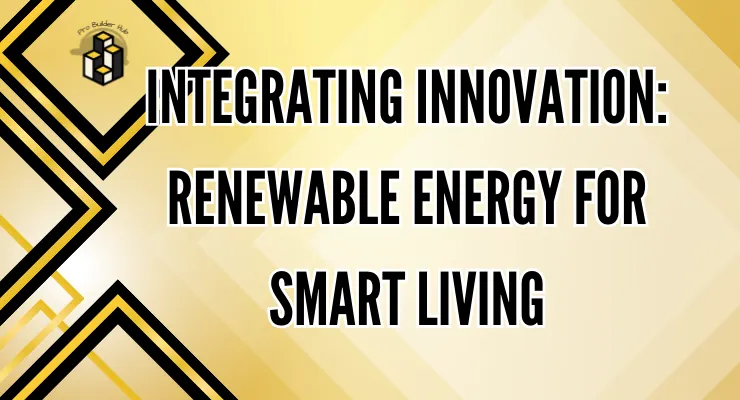
Renewable Energy Integration in Smart Buildings

Integrating renewable energy sources into smart buildings is critical to promoting sustainability, lowering carbon emissions, and increasing energy efficiency. Smart buildings can reduce their environmental effect and reliance on nonrenewable energy by utilizing clean energy sources such as solar panels and wind turbines. This integration promotes energy independence by allowing buildings to generate and manage their own energy needs more efficiently, resulting in cost savings and enhanced resilience to grid disruptions. Overall, incorporating renewable energy into smart buildings is an important method for moving toward a greener, more sustainable future.
Below are some advanced methods and technologies for incorporating renewable energy into smart buildings:
1. Solar Power Systems

Photovoltaic (PV) Panels
PV panels turn sunlight directly into electricity, making them a popular renewable energy source for buildings.
Rooftop Solar Panels: Installing solar panels on rooftops is a widespread method of producing on-site renewable energy. These panels can be adjusted for optimal sunshine exposure and energy output.
Building-Integrated Photovoltaics (BIPV): These systems incorporate solar panels into building components like windows and facades. This dual-purpose strategy enables buildings to generate electricity while remaining visually appealing.
Solar Thermal Systems
Solar thermal systems harness sunlight to heat water or air for use in buildings.
Solar Water Heaters: These systems use solar collectors to heat water, which can then be used for hot water or space heating.
Concentrated Solar Power (CSP): CSP systems employ mirrors to focus sunlight on a small area, generating high-temperature heat that can be used for power generation or industrial processes.
2. Wind Energy

Small-Scale Wind Turbines
Small wind turbines can be installed on building rooftops or in neighboring open places to harvest wind energy.
Vertical Axis Wind Turbines (VAWTs): VAWTs are ideal for urban situations due to their capacity to capture wind from any direction and low noise levels.
Horizontal Axis Wind Turbines (HAWTs): While more efficient, HAWTs must be strategically placed to maximize wind collection, which is frequently done in less densely inhabited areas or at higher elevations.
Integration with Building Design
Wind turbines can be integrated into building architecture, such as using building-mounted turbines or wind channels to funnel and accelerate wind flow.
3. Geothermal Energy

Ground Source Heat Pumps (GSHPs)
GSHPs use the ground's steady temperature to provide heating and cooling for buildings.
Closed-Loop Systems: These systems circulate a refrigerant through underground pipes to transmit heat from the building to the earth.
Open-Loop Systems: These systems use groundwater directly and transport heat to and from the building via a heat exchanger.
Direct Geothermal Heating
Buildings in areas with high geothermal activity can use geothermal wells to directly access hot water or steam for heating.
4. Energy Storage Systems

Battery Storage
Battery systems store extra energy provided by renewable sources for later use, ensuring a consistent energy supply even when generation levels are low.
Lithium-Ion Batteries: Widely utilized because of their high energy density and efficiency. These batteries can be incorporated into building energy management systems to improve energy efficiency and storage.
Flow Batteries: Ideal for larger-scale applications, flow batteries have a longer cycle life and can be easily scaled up.
Thermal Storage
Thermal storage systems retain excess heat or cold for subsequent use in heating or cooling applications.
Molten Salt Storage: Molten salt is generally used in CSP systems to store high-temperature heat for extended periods of time.
Ice Storage: Systems that produce ice during off-peak hours and use it to cool during high demand periods.
5. Microgrids and Smart Grids

Microgrids
Microgrids are small energy networks that can function independently or in tandem with the main power grid.
Resilience and Reliability: Microgrids improve energy resilience by enabling buildings to function independently during grid interruptions. They can use a variety of renewable energy sources and storage devices to ensure a steady power supply.
Energy Sharing: Buildings in a microgrid can share excess energy, improving overall energy efficiency and decreasing waste.
Smart Grids
Smart grids utilize digital technologies to efficiently control and distribute electricity throughout the power grid.
Demand Response: Smart grids allow buildings to engage in demand response programs, which modify energy consumption during peak hours to balance supply and demand.
Real-Time Monitoring and Control: Smart grids give real-time data on energy consumption and generation, enabling more efficient and adaptable energy management.
6. Energy Management Systems (EMS)

Building Energy Management Systems (BEMS)
BEMS integrates and optimizes the utilization of diverse renewable energy sources throughout the structure.
Real-Time Monitoring: BEMS monitors energy production and consumption in real time, offering insights for optimizing energy use and finding inefficiencies.
Automated Controls: These systems can automate the operation of renewable energy systems, such as altering solar panel orientations and managing energy storage and delivery.
Predictive Analytics
Predictive analytics, which incorporates AI and machine learning, can forecast energy demand and generation, allowing for proactive energy management.
Weather Forecasting: Predictive models can use weather data to forecast solar and wind energy generation, allowing renewable energy systems to operate more efficiently.
Load Forecasting: Predictive analytics can estimate building energy consumption, enabling for better integration and usage of renewable energy.
7. Green Building Certifications

LEED (Leadership in Energy and Environmental Design)
LEED certification acknowledges buildings that use renewable energy and other environmentally friendly measures.
Energy and Atmosphere Credit: Points are provided for the use of renewable energy systems, energy-efficient design, and improved energy efficiency.
BREEAM (Building Research Establishment Environmental Assessment Method)
BREEAM examines buildings' environmental performance, including the use of renewable energy.
Energy Credits: BREEAM provides credits for using renewable energy, energy-efficient systems, and creative energy solutions.
Conclusion
Integrating renewable energy into smart buildings improves sustainability, lowers operational costs, and increases energy independence. Smart buildings can improve their energy efficiency and contribute to a more sustainable future by utilizing technology such as solar and wind power, geothermal systems, energy storage, and smart grids. As renewable energy and smart building technologies progress, the possibility for completely sustainable and self-sufficient buildings grows.

Our Mission
At ProBuilderHub, we strive to empower small businesses and corporations by providing an all-in-one software solution that promotes growth and success, especially for contractors. We believe in facilitating access to a wide range of industries and bridging the gap between skilled individuals and businesses. Our mission is to create a community in which expertise is appreciated and opportunities abound, allowing businesses of all sizes to thrive and succeed.



